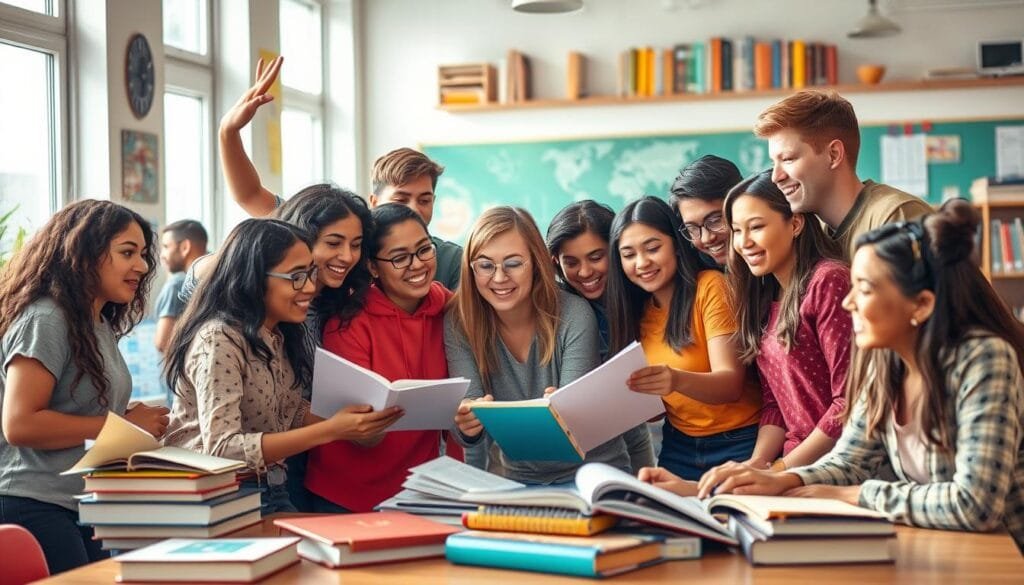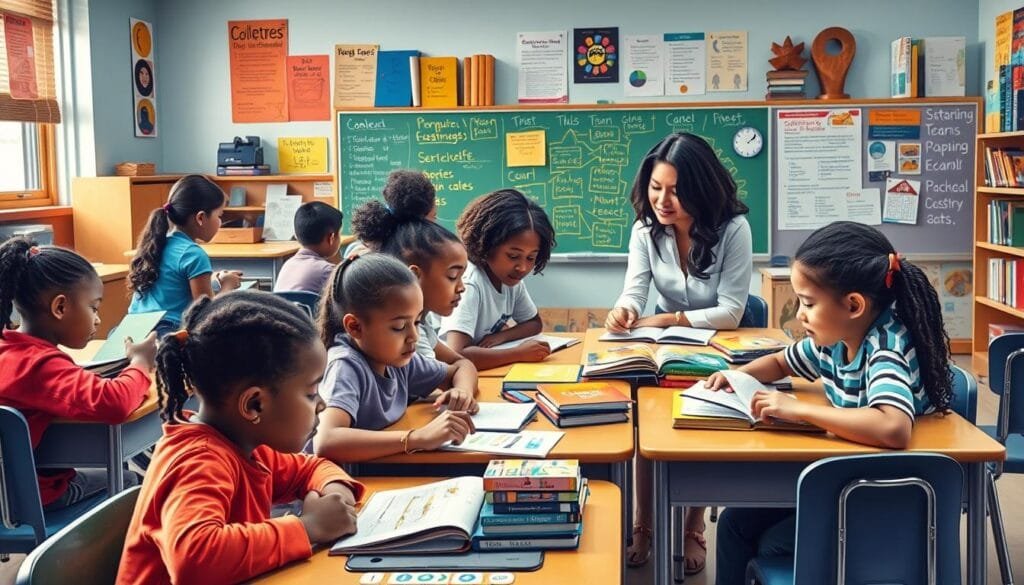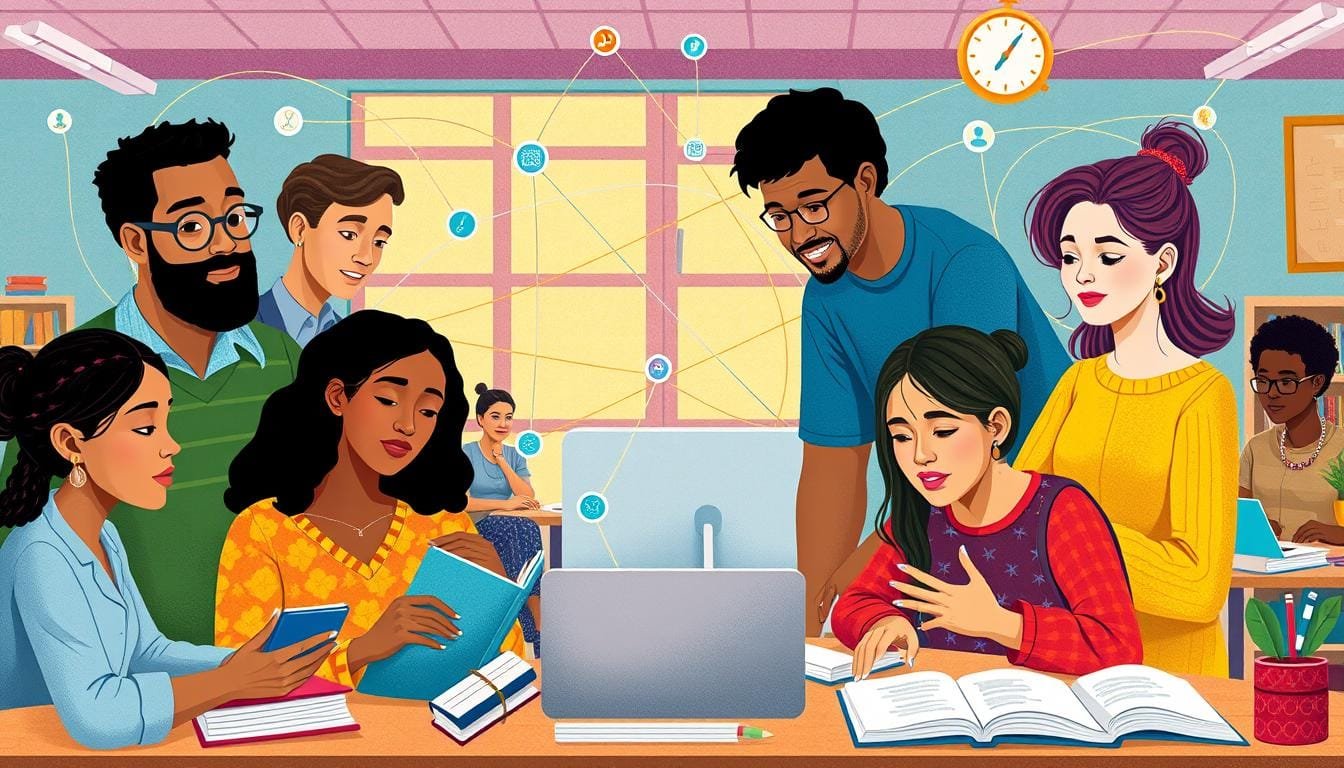In our world, education helps us connect with each other. It makes learning change lives and shows us ways to be active in society through learning. This guide explores how teachers can link what we learn to bigger ideas. It helps students see how their lessons matter to them and others. For example, the IDialogue project has reached 7,000 teachers and impacted 100,000 students across 140 countries1. It shows the strength of educational connections.
Programs like PenPal Schools and the Digital Exchange Program let students from different places talk and work together. They help create a world where learning has no borders1.
Key Takeaways
- Educational initiatives are seamlessly linking learners across the globe, fostering understanding and empathy.
- Cocurricular activities enhance the development of career readiness competencies, aligning with employer expectations2.
- Tools like PenPal Schools harness the benefits of digital technology in education by facilitating virtual exchanges1.
- Effective community involvement in education can lead to higher student achievement, as seen in the Oakland Unified School District3.
- Safety in digital learning environments remains a priority, with resources such as the ICAC Task Force Program providing valuable content3.
Building Community Through Educational Engagement
Today, building a community in schools is very important. It brings everyone closer together and makes learning more fun and meaningful. Schools become more than just places to learn, but spaces where everyone can grow and feel part of something bigger.
Creating Inclusive Classroom Spaces
Inclusive classes make everyone feel important and valued. Everyone gets to share their own stories and cultures. This makes conversations richer and helps everyone understand different views better. Everyone learns more and supports each other.
Community-based Learning Initiatives
Learning with the community links what students learn in class to the real world. It connects them with local groups and leaders. By doing this, students not only learn better but also get involved in their communities for life.
Role of Extra-curricular Activities in Fostering Connections
Extra-curricular activities help students find new passions outside their schoolwork. Activities like sports, arts, and clubs teach important social and leadership skills. They also help students form connections and become more well-rounded.
Research from places like the Medical College of Wisconsin shows how important community and extra activities are4. They help keep students happy and staying in school. Inclusive education also plays a big part in helping students succeed academically and personally5.
| Activity | Benefits |
|---|---|
| Sports and Physical Education | Improves physical health, teaches teamwork, and develops leadership skills. |
| Arts and Music Programs | Encourages creativity, enhances cognitive abilities, and provides emotional outlet. |
| Community Service | Builds empathy, enhances social awareness, and fosters community engagement. |
| Science and Tech Clubs | Promotes critical thinking, fosters innovation, and prepares for future careers. |
Adding these elements to education does more than just fill the schedule. It deeply enriches learning. It makes school a welcoming, inclusive, and exciting place for everyone.
Fostering Cross-Cultural Understanding and Respect
Education is key in bringing together diverse groups by improving cross-cultural learning. Schools with a multicultural focus help students explore and enjoy the world’s rich cultural mix.
Study Abroad Programs and Global Awareness
It’s vital to learn about and engage with other cultures to build mutual respect in our connected world. Study abroad programs are great for this. They put students in new cultures, fostering deep growth. These journeys are more than travel; they’re about sharing ideas and understanding the world’s variety6.
Integrating Multicultural Education in Curriculum
Studies show that including cultural studies in education helps students think critically and solve problems better7. Multicultural education is also crucial for economic growth. It encourages a culture of teamwork, innovation, and creativity in diverse settings7.
Celebrating Diversity Through School Events and Traditions
Schools celebrate diversity with events that showcase various cultures. These activities teach students and connect them to wider cultural stories. They foster communities of respect and understanding.

Schools committed to cross-cultural learning might host cultural festivals. These events are fun and bring people together, boosting community bonds and helping the local economy by drawing in visitors7.
| Aspect | Benefit |
|---|---|
| Cross-Cultural Programs | Enhance understanding and respect among diverse groups |
| Multicultural Curriculum | Improves critical thinking and global competence |
| Cultural Events | Strengthens community ties and promotes local economic benefits7 |
By focusing on these strategies, schools can not only accept diversity but also celebrate it. These efforts prepare students for a diverse world, fostering peace and understanding across cultures.
How Does Education Bridge People to Other People
Education does more than just give knowledge. It acts as a strong educational bridge to connect people from different places. By creating valuable learning relationships, schools make sure everyone feels included and understood.
“Studies in Compassion” is a new course that has made learning environments safer and more interesting8. Programs that let students discover common values have also made social connections stronger. They have created a sense of community among students8.
Using the Bridging Differences tactic in lessons has changed the game. It leads to more student participation and values everyone’s views. This makes classrooms more peaceful8.
Such efforts help students who face personal challenges. They do better in school and feel they belong8.
- Empowerment and value felt by students8
- Transformative teaching methods via technology deployment9
- Enhanced soft skills, including resilience and creativity through modern educational tools9
With technology changing education, adapting is key9. Groups like Nepris and Invest IN are crucial. They link education with real-world skills through internships and workshops9.
Education’s role goes beyond grades. It also helps in personal and professional growth. This has a wide educational impact on our society.
Empowering Student Leadership and Voice
Boosting student leadership and voice in schools is key. It creates a friendly learning space that honors every learner’s potential. Schools that let students help make decisions show them how important their roles and choices are.
Developing Student Governance Structures
Having strong student governance encourages voices to be heard in school matters. It teaches leadership and builds a sense of duty and belonging10. Using programs like Amplify, which highlight leadership and student input, is a great start.
Encouraging Student-led Initiatives and Clubs
Clubs and initiatives led by students are essential. They help grow leadership skills and encourage active engagement. Engaging in these activities makes students more involved and responsible for their learning. Projects like ‘Fairness And Friendship’ greatly boost this involvement10.
Student Participation in School Decision-making Processes
Allowing students a say in school decisions is crucial. It connects them more closely with educators, making learning more open and fair. Research shows this leads to better engagement and results11.
Such decision-making inspires a respectful culture. Schools become places where students’ contributions are valued. Including student suggestions in tasks improves involvement and confidence11.
| Component | Description | Impact on Student Leadership |
|---|---|---|
| Student Voice | Students express opinions and influence decisions | Enhances engagement and ownership |
| Student Agency | Students act independently with power over learning | Builds autonomy and leadership skills |
| Student Governance | Students participate in school management | Develops responsibility and community service |

For more on the importance of student leadership, see the Rennie Center’s 2019 Action Guide.
Enhancing Educational Accessibility for Marginalized Communities
Making education fair means helping marginalized groups get what they need. In the U.S., 42 million people lack home internet. This lack stops them from using online learning tools and taking part in important school activities12.
A survey showed most teachers say only 75% of their students have good internet at home. This makes it hard for kids to learn online. To fix this, we could give out cheap mobile devices or start Wi-Fi zones for the community12.
Money problems stop many poor families from sending their kids to school13. Not having enough good teachers makes it even harder for these students to succeed13.
Flexible payment plans for school have helped a lot, especially in Indonesia and the Philippines12. Scholarships and financial help are also key. They make sure all students have a chance to learn, no matter their background13.

When companies treat online degrees like traditional ones, it helps a lot12. They can work with schools to create special programs that meet different learning needs12.
AI in education customizes learning so all students can keep up12. Investing in this tech and in school infrastructure can change education for the better in remote places13.
Everyone in the community must help overcome the culture and social issues blocking education. We all need to support an environment where every student gets the same chance to learn13.
Utilizing Technology to Connect Learners Globally
Technology now is a key part of creating a worldwide digital education. It helps make a learning world without borders. This change comes from online learning, social media, and virtual exchanges. They aim to make learning better and reachable for everyone.
Online Learning Platforms and Virtual Exchange Programs
Online platforms and virtual exchanges give students all over the world access to education. They offer not just lessons but also interactive and cross-cultural learning. Technologies, like Explorance MLY, help make digital learning better by understanding student feedback14. Also, learning systems bring together digital books and media, making online education richer14.
Social Media as a Tool for Educational Collaboration
Social media is now a strong educational tool. It helps with discussions, sharing resources, and learning together. Educators use popular platforms to make learning fun and interactive. Games in learning can greatly make students more involved14.
Digital Mentorship Programs and Webinars
Webinars and digital mentorship are key for online learning. They give students a chance to learn straight from experts. These interactions link theory with real-world uses and open up global insights. This increases student interest and widens their learning view14.
Adding technology in education helps students learn better and get essential digital skills. Skills like managing information, being adaptable, and knowing cybersecurity are key today. As technology in education evolves, it will keep shaping the global education scene. It makes learning possible for everyone14.
Conclusion
Exploring educational change reminds us it’s more than just regular learning. Colleges help build bigger social networks and reduce loneliness15. As education becomes more global, the divide grows between those with and without quality learning opportunities16. It’s crucial to support every student, helping them succeed in a well-connected world.
Education plays a key role in connecting different cultures, fostering understanding and empathy. Many countries value free speech, showing the importance of communication. Yet, 14% of adults worldwide struggle with reading and writing16. Global education can lead us to a more inclusive society where everyone can share their voice and follow their dreams16.
This article highlights the need for teamwork and new ideas in education. Noah Rachlin talks about the importance of linking various schools and educators for educational change16. Educational transformation focuses on the child and the factors affecting their learning. This approach builds positive learning spaces, boosting students’ academic and personal growth. It paves the way for an impactful and lasting educational journey.
FAQ
How can education facilitate deeper social engagement among students?
Education helps students get involved socially through clubs, community learning, and inclusive spaces. These activities make students active in their communities. It builds a strong sense of belonging among them.
What are the benefits of integrating multicultural education into the curriculum?
Multicultural education helps students understand and respect different cultures. It challenges one-sided views and supports a diverse learning experience. This approach promotes global awareness and celebrates diversity in schools.
How does studying abroad contribute to educational connections?
Studying abroad opens students up to new cultures and global awareness. It helps them make friends from around the world.
These connections support their growth and learning.
Why is student leadership and involvement in decision-making important in schools?
Allowing students to lead and make decisions empowers them. It helps them learn leadership and makes sure their voices are heard. This shapes a meaningful educational journey for them.
In what ways can technology enhance global educational connectivity?
Technology connects students worldwide through e-learning and social media. It offers mentorship and webinars.
It plays a big part in global education.
How can educational institutions support marginalized communities to achieve educational equity?
Schools help marginalized communities by providing better access to resources. They use fair rules and create welcoming classrooms. This improves fairness in education.
What role do extra-curricular activities play in connecting students with their community?
Extra-curricular activities let students try new things and meet others. They join clubs and sports.
This connects them with their community.
How do celebrations of diversity contribute to a transformative learning environment?
Events that celebrate different cultures teach respect and understanding. They transform learning by making it inclusive and rich. This strengthens students’ connections.
Why is personalized learning important in connecting students with their education?
Personalized learning ties education to students’ own lives and dreams. It considers their backgrounds.
This makes learning engaging and meaningful for them.
Can social media be effectively used for educational purposes?
Yes, social media supports education by allowing knowledge sharing and discussions. It fosters collaboration.
This enhances learning in and out of the classroom.
